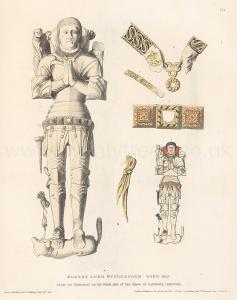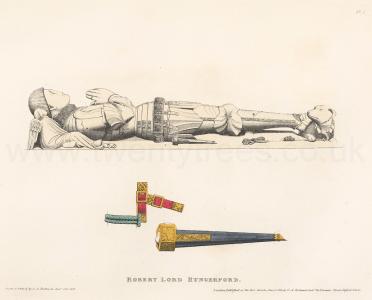Effigy of Robert Lord Hungerford
Effigy of Robert Lord Hungerford is in Monumental Effigies of Great Britain.
Robert Hungerford 2nd Baron Hungerford
WAS descended from an ancient Wiltshire family. He was the son and heir of Walter Lord Hungerford by his wife Catherine, and was born about the year 1409. His father (distinguished by his military services in the reigns of Henry the Fourth and Fifth) was one of the executors of the last-mentioned monarch, and under Henry the Sixth Captain of the Castle of Cherbourg, Steward of the Royal Household, and Treasurer of the Exchequer. He died in 1449, when Robert, his eldest son, the subject of this notice, succeeded him in his estates. Robert served during the lifetime of his father in the wars in France, under John Duke of Bedford; and in 1453 was in that expedition into Guienne which proved so fatal to Talbot Earl of Shrewsbury and his son the Lord Lisle. Robert Lord Hungerford's sona by his wife, Margaret, daughter of Lord Botreaux, accompanied him, and was taken prisoner in the disastrous affair at Chastillon, which, under the head of Talbot Earl of Shrewsbury, we have already detailed. Lord Hungerford died 22d April, 1459, and directed by his last will that he should be buried near the altar of St. Osmund, in the cathedral church of Salisbury [Map], where his father had founded a chantry, and where his own widow, Margaret, also established another.


Note a. This son was styled the Lord Moleyns, in right of his wife. He remained prisoner in France upwards of seven years. Dugdale has detailed the curious items of the "vast charges" his mother, Margaret, incurred to support him and his family during his captivity, to pay his debts, previously contracted, and to procure his ransom. These charges amounted in the aggregate to nearly 20,0001. of which the sum for the ransom was 7,6901. See Baronage, Vo!. II. p. 209.
In 1789, during the repairs and alterations which took place in the cathedral, his body was removed from its original resting-place into the nave of the church. His remains were found deposited in a wooden coffin, lying above the level of the floor. The skeleton was nearly entire, and measured in length five feet five inches. From Dodsworth's accounta, it would appear that he had been placed in his coffin in the same attitude in which the effigy appears on his tomb. The costume of Lord Hungerford presents a fine example of plate armour. The surcoat, or tabard, began now to be much disused, the fine effect of the metallic splendour of the steel being appreciated. The surface of the suit is now elaborated fluted, or channelled. Lord Hungerford wears a rich hip-girdle, and the badge of SS. or Souverayne, devised by Henry the Fourth, and adopted by the monarchs of his line. At his feet is a hound, with a collar and leash.
Details. Plate I. 1. The eihgy as originally painted. 2. Collar of SS. and pendant jewell enlarged. 3. Lace on the vambrace. 4. Details of the hip-girdle. 5. One of the laces of the elbow-pieces.
Plate II. Profile. Lace of the dagger, straps with embossed mountings attaching the tassets. Scabbard, and mountings of the dagger.
Note b. Historical Account of Salisbury Cathedral, p. 196.

